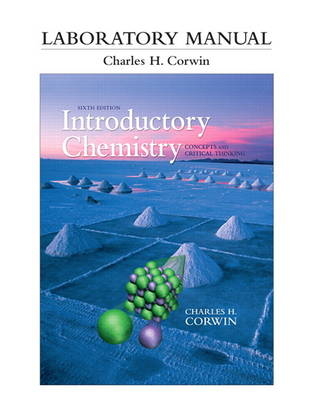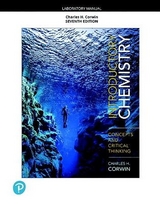
Laboratory Manual for Introductory Chemistry
Pearson (Verlag)
978-0-321-75094-5 (ISBN)
- Titel erscheint in neuer Auflage
- Artikel merken
Charles H. Corwin has spent over 30 years teaching chemistry to over 10,000 students. He has taught general chemistry, organic chemistry, and quantitative analysis, but has focused primarily on introductory chemistry for the personal rewards it offers. Corwin took his degrees at San Jose State University, where he was a member of Tau Delta Phi honor society. Early in his career, he was awarded a National Science Foundation grant to study instructional innovations at Grand Valley State University. Currently, he is a professor of chemistry at American River College, where he was recognized as Teacher of the Year in 1994. He is also the recipient of an Alumni Teaching award from Purdue University.
SAFETY PRECAUTIONS
LOCKER INVENTORY
WASTE DISPOSAL
EXPERIMENTS
1 Introduction to Chemistry
Topic: The Scientific Method
A. Instructor Demonstrations
B. Student Experiments2 Instrumental Measurements
Topic: The Metric System
A. Length Measurement
B. Mass Measurement
C. Mass and Volume of an unknown solid
D. Volume Measurements
E. Temperature Measurements3 Density of Liquids and Solids
Topic: Density
A. Instructor Demonstration
B. Density of Water
C. Density of an Unknown Liquid
D. Density of a Rubber Stopper
E. Density of an Unknown Solid
F. Thickness of Aluminum Foil4 Freezing Points and Melting Points
Topic: Change of Physical State
A. Cooling Curve and Freezing Point
B. Melting Point of an Unknown5 Physical Properties and Chemical Properties
Topic: Physical and Chemical Properties
A. Physical Properties
B. Chemical Properties6 “Atomic Fingerprints”
Topic: Emission Spectra and Electron Energy Levels
A. Continuous Spectrum – White Light
B. Line Spectrum – Hydrogen
C. Line Spectra – Helium, Neon, Argon, Krypton, and Mercury
D. Identifying Unknown Elements in a Fluorescent Light7 Families of Elements
Topic: The Periodic Table
A. Analysis of Known Solutions
B. Analysis of an Unknown Solution8 Identifying Cations in Solution
Topic: Qualitative Cation Analysis
A. Analysis of a Known Cation Solution
B. Analysis of an Unknown Cation Solution9 Identifying Anions in Solution
Topic: Qualitative Anion Analysis
A. Analysis of a Known Anion Solution
B. Analysis of an Unknown Anion Solution10 Analysis of a Penny
Topic: Writing and Balancing Chemical Equations
A. Instructor Demonstrations-Combination Reactions
B. Decomposition Reactions
C. Single-Replacement Reactions
D. Double-Replacement Reactions
E. Neutralization Reactions
F. Percentages of Copper and Zinc in a Penny11 Determination of Avogadro’s Number
Topic: Avogadro’s Number and the Mole Concept
A. Calibrating a Dropper Pipet
B. Calculating Molecules in the Monolayer
C. Determining Avogadro’s Number12 Empirical Formulas of Compounds
Topic: Empirical Formula
A. Empirical Formula of Magnesium Oxide
B. Empirical Formula of Copper Sulfide13 Analysis of Alum
Topic: Percent Composition and Empirical Formula
A. Percentage of Water in Alum Hydrate
B. Percentage of Water in an Unknown Hydrate
C. Water of Crystallization in an Unknown Hydrate14 Decomposing Baking Soda
Topic: Mass–Mass Stoichiometry and Percent Yield
A. Percent Yield of Na2CO3 from Baking Soda
B. Percentage of NaHCO3 in an Unknown Mixture15 Precipitating Calcium Phosphate
Topic: Mass–Mass Stoichiometry and Percent Yield
A. Percent Yield of Ca3(PO4)2 from CaCl2
B. Percentage of CaCl2 in an Unknown Mixture16 Generating Hydrogen Gas
Topic: Mass–Volume Stoichiometry and Combined Gas Law
A. Molar Volume of Hydrogen Gas
B. Atomic Mass of an Unknown Metal17 Generating Oxygen Gas
Topic: Mass–Volume Stoichiometry and Combined Gas Law
A. Percentage of KClO3 in a Known Mixture
B. Percentage of KClO3 in an Unknown Mixture18 Molecular Models and Chemical Bonds
Topic: Chemical Bonding and Electron Dot Formulas
A. Molecular Models with Single Bonds
B. Molecular Models with Double Bonds
C. Molecular Models with Triple Bonds
D. Molecular Models with Two Double Bonds
E. Unknown Molecular Models19 Analysis of Saltwater
Topic: Solubility and Solution Concentration
A. Solutes and Solvents
B. Rate of Dissolving
C. Demonstration of Supersaturation
D. Concentration of Sodium Chloride in Saltwater20 Analysis of Vinegar
Topic: Acid–Base Titrations
A. Preparation of Standard Sodium Hydroxide Solution
B. Concentration of Acetic Acid in Vinegar21 Electrical Conductivity of Aqueous Solutions
Topic: Net Ionic Equations
A. Conductivity Testing—Evidence for Ions in Aqueous Solution
B. Conductivity Testing—Evidence for a Chemical Reaction
C. Net Ionic Equations—A Study Assignment22 Activity Series of Metals
Topic: Oxidation–Reduction Reactions
A. Oxidation Numbers of Manganese
B. Oxidation Numbers of Chromium
C. Oxidation Numbers of Sulfur
D. Oxidation Numbers of Nitrogen
E. Oxidation–Reduction Equations
F. Activity Series and an Unknown Metal23 Organic Models and Functional Groups
Topic: Classes of Organic Compounds
A. Molecular Models of Hydrocarbons
B. Molecular Models of Hydrocarbon Derivatives
C. Unknown Molecular Models24 Separation of Food Colors and Amino Acids
Topic: Separation of Biochemical Compounds
A. Separation of Food Colors by Paper Chromatography
B. Identification of Amino Acids by Paper Chromatography25 Laboratory Instruments and Technique
Topic: Lab Final Exam
A. Lab Practical Exam
B. Lab Written ExamAPPENDICES
A Laboratory Burner
B Decigram Balance
C CentigramBalance
D Milligram Balance
E Volumetric Pipet
F Activity Series for Metals
G Solubility Rules
H Laboratory Notebook
I Glossary
J Answers to Prelaboratory Assignments
| Erscheint lt. Verlag | 23.2.2012 |
|---|---|
| Sprache | englisch |
| Maße | 225 x 275 mm |
| Gewicht | 661 g |
| Themenwelt | Schulbuch / Wörterbuch |
| Naturwissenschaften ► Chemie | |
| ISBN-10 | 0-321-75094-2 / 0321750942 |
| ISBN-13 | 978-0-321-75094-5 / 9780321750945 |
| Zustand | Neuware |
| Informationen gemäß Produktsicherheitsverordnung (GPSR) | |
| Haben Sie eine Frage zum Produkt? |
aus dem Bereich



